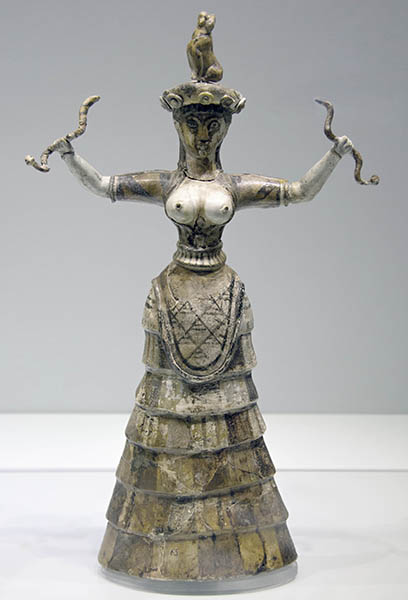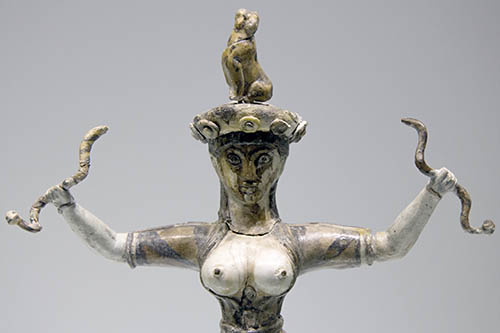While the Minoan Snake Goddess is one of the most reproduced and familiar images in the art historical canon her functionand indeed her very essencecontinues to be shaped by the man who coined the term Minoan and discovered the site in which she and her sisters lay for generations undisturbed. At the Palace of Knossos by archaeologist Arthur Evans and dated to the Minoan civilization c.
The actual representation of the Snake Goddess is unknown.

. She is both terrifying and beneficent. What is the meaning of the The Snake Goddess. In other words he was a prophet.
The actual representation of the Snake Goddess is unknown. However a majority of perceptions would all agree that the Snake Goddess is an important female deity in Minoan civilization. She is called also Household Goddess due to her attribute of the snake which is connected with the welfare of the Minoan household.
Learn content analysis with free interactive flashcards. The Snake Goddess was one of the Minoan divinities associated closely with the snake cult. We need to be careful not to read into.
See Chris Witcombes essay on the Minoan Snake Goddess. The Great Goddess unites opposites within herself. The distinctive look of the figurines long flaring skirts opened bodices carefully arranged hair with distinctive headdresses and the snakes as accoutrements persists in dominating.
Having identified the Snake Goddess as a fertility deity associated with the Mother Goddess most archaeologists and art historians seem content to leave it at that as if the term fertility deity somehow explains the meaning of the figurine. Two Minoan snake goddess figurines are a group of ancient sculptures that were excavated in 1903 in the Minoan palace at Knossos in the Greek island of Crete. How tall was the snake goddess.
On the other hand Athena wore a snake finged poncho or aegis and the Minoan Snake Goddess is a divine figure holding two snakes in her hand. When Sir Arthur Evans concluded. The decades-long excavation programme led by the English archaeologist Arthur Evans greatly expanded knowledge and awareness of the Bronze Age Minoan civilization but Evans has subsequently been criticised.
This is still the symbol of the medical profession the. I chose to analyze a sculpture named Snake Goddess from the ancient Minoan civilization dating back to 1600 BCE. In 1903 Sir Arthur Evans excavating at the palace of Knossos on the island of Crete discovered fragments of faience statuettes depicting female figures holding snakes.
The statuette is composed of faience which is a low-fired glasslike silicate. Women in the Aegean Minoan Snake Goddess. However a majority of perceptions would all agree that the Snake Goddess is an important.
Minoan Snake Goddess ca. Lapatin actually goes into details about Arthur Evans his influences on what made him believe the famous snake woman statue is a goddess and the other archaeologists around him. It was Evans who called the figurine a Snake.
To describe the size of the snake goddess. Figurines typically referred to as Snake Goddesses. She is dressed in the typical Minoan clothes with a long skirt and a tight open bodice that leaves her breasts uncovered and she holds a snake in each hand.
The so-called Snake Goddess from Knossos possibly presents the Great Goddess as she was conceived of within Minoan culture. The faïence figurine was made between 1600-1580 BCE and the creator remains unknown. Choose from 500 different sets of content analysis flashcards on Quizlet.
While the idols true function is. How he attained the gift of prophecy however is a curious one and worth exploring so in this post were going to take a look at the myths surrounding the figure of Tiresias and his role. The Snake Goddess Analysis.
The Snake Goddess. The interpretation of this figure as a goddess is also difficult since there is no evidence of what a Minoan goddess might have looked like. This 3500-year-old figurine depicts a woman with bare breasts holding a snake in each of her raised hands.
Is one of the most good known female deitys and faience statuettes in Minoan civilization Patron. Since the snake is also symbol of the underworld deity the Snake Goddess has some chthonic aspects as well. The Snake Goddess is a provocative image but its restoration and interpretation are problematic.
It was found at a Minoan archaeological site in Crete. The Snake Goddess a voluptuous divine figure with bare breasts and snakes in both hands is one of the most well known female deitys and faïence figurines in Minoan culture Patron. The theory of the sculptures.
In Greek mythology and literature Tiresias was a seer or soothsayer. The crown and cat have no parallel in any image of a Bronze Age woman so these should be discounted. A bulk of perceptual experiences would all hold that the Snake Goddess is an of.
This figurine of a woman holding a snake in either hand with a cat sitting on top of her head was discovered by Arthur Evans in the original excavation of the Pallace of Knossos. And serpents in both custodies. These figures became iconic images of Minoan civilization as soon as they were published and ever.
Their elegant fashionable costumes their physical gracefulness their sensitive yet forthright personalities their sophisticated tastes and love of luxury their refined manners and worldly. The Snake Goddess in Minoan Culture. The Snake Goddess a voluptuous divine figure with bare breasts and snakes in both hands is one of the most well known female deitys and faïence figurines in Minoan culture Patron.
Two of these statuettes were extensively restored and identified by Evans as a Mother Goddess and a Priestess. This sculpture is relatively small about 1 1 12 high from its base and is from the palace of Knossos. A Summary and Analysis of the Myth of Tiresias.
What is the snake goddess made of. Snakes were associated with their power to kill but were positive attributes. Godly figure with bare chests.
The faience figurine identified as Snake Goddess was discovered in 1903 by Arthur Evans in the Temple Repositories of the Knossos palace in the island of Crete in Greece. The figure stands bare chested with the hands. Other examples of this motif have since been discovered reinforcing the idea that the small sculpture portrays a deity of some kind.
The Snake Goddess. The existent representation of the Snake Goddess is unknown. Part of the attraction of the figurines is that they can be interpreted as embodying many of the perceived and admired characteristics of the Minoans.
In 1903 British archaeologist Arthur Evans found the faïence figurine which is known as The Snake Goddess in Minoan archaeological sites in Crete. This particular study of the Minoan Snake Goddess is one that does not solely rely on the original or new archaeological data. Light darkness upper and lower worlds birth-death-and re-birth.
What is the term used to describe how the snake goddess holds the snake in her hand. Aclepius the god of healing has as a symbol a snake around a rod.

Snake Goddess Article Minoan Khan Academy

0 Comments